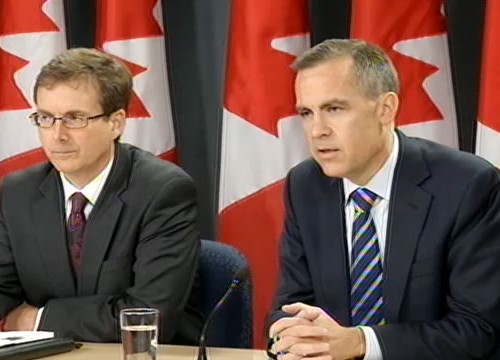Release of the Monetary Policy Report
Available as:
PDF
Good morning. Tiff and I are pleased to be here with you today to discuss the October Monetary Policy Report, which the Bank published this morning.
- The global economy has slowed markedly as several downside risks to the projection outlined in the Bank’s July MPR have been realized. Volatility has increased and there has been a generalized retrenchment from risk-taking across markets. The combination of ongoing deleveraging by banks and households, increased fiscal austerity and declining confidence is expected to restrain growth across the advanced economies.
- The Bank now expects that the euro area—where these dynamics are most acute—will experience a brief recession. The Bank’s base-case scenario nonetheless assumes that the euro-area crisis will be contained, although this assumption is clearly subject to downside risks.
- In the United States, real GDP growth is expected to be weak through the first half of 2012, reflecting diminished household confidence, tighter financial conditions and increased fiscal drag.
- Growth in China and other emerging-market economies is projected to moderate to a more sustainable pace. These developments, combined with recent declines in commodity prices, are expected to dampen global inflationary pressures.
- The outlook for the Canadian economy has weakened since July, with the significantly less favourable external environment affecting Canada through financial, confidence and trade channels. Although Canadian growth rebounded in the third quarter with the unwinding of temporary factors, underlying economic momentum has slowed and is expected to remain modest through the middle of next year.
- Domestic demand is expected to remain the principal driver of growth over the projection horizon. Household expenditures are now projected to grow relatively modestly as lower commodity prices and heightened volatility in financial markets weigh on the incomes, wealth and confidence of Canadian households.
- Business fixed investment is still expected to grow solidly in response to very stimulative financial conditions and heightened competitive pressures, although it will be dampened by the weaker and more uncertain global economic environment.
- Net exports are expected to remain a source of weakness, owing to sluggish foreign demand and ongoing competitiveness challenges, including the persistent strength of the Canadian dollar.
- Overall, the Bank expects that growth in Canada will be slow through mid-2012 before picking up as the global economic environment improves, uncertainty dissipates and confidence increases.
- The weaker economic outlook implies greater and more persistent economic slack than previously anticipated, with the Canadian economy now expected to return to full capacity by the end of 2013. As a result, core inflation is expected to be slightly softer than previously expected, declining through 2012 before returning to 2 percent by the end of 2013.
- The projection for total CPI inflation has also been revised down, reflecting the recent reversal of earlier sharp increases in world energy prices as well as modestly weaker core inflation. Total CPI inflation is expected to trough around 1 per cent by the middle of 2012 before rising with core inflation to the two per cent target by the end of 2013, as excess supply in the economy is slowly absorbed.
- There are several significant risks to the inflation outlook in Canada.
- The three main upside risks relate to the possibility of stronger-than-expected inflationary pressures in the global economy, stronger momentum in Canadian household spending, and the possibility of a faster-than-expected rebound in business and consumer confidence, due to more decisive policy action in the major advanced economies.
- The three main downside risks relate to sovereign debt and banking concerns in Europe, the increased probability of a recession in the U.S. economy, and the possibility that growth in household spending in Canada could be weaker than projected.
- Reflecting all of these factors, the Bank yesterday maintained the target for the overnight rate at 1 per cent. With the target interest rate near historic lows and the financial system functioning well, there is considerable monetary policy stimulus in Canada. The Bank will continue to monitor carefully economic and financial developments in the Canadian and global economies, together with the evolution of risks, and set monetary policy consistent with achieving the 2 per cent inflation target over the medium term.
With that, Tiff and I would be pleased to take your questions.

